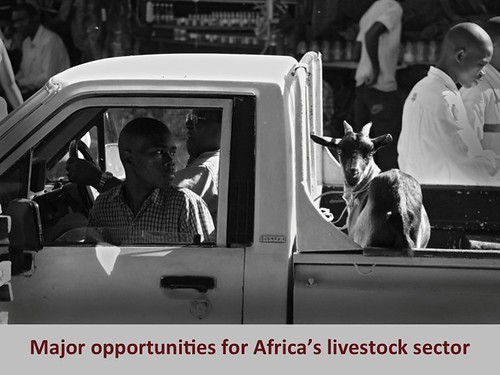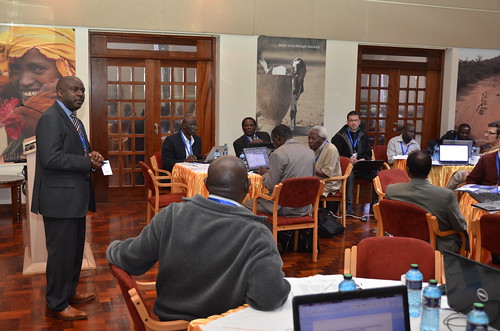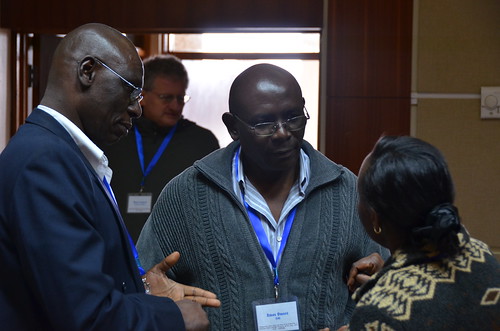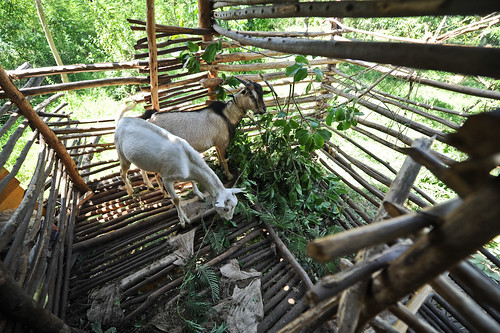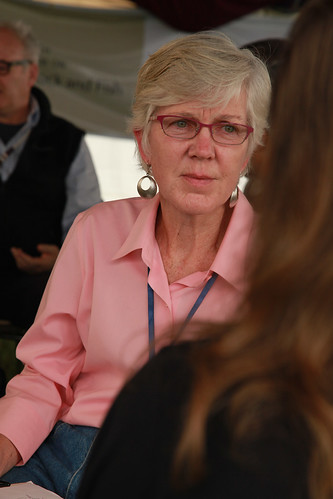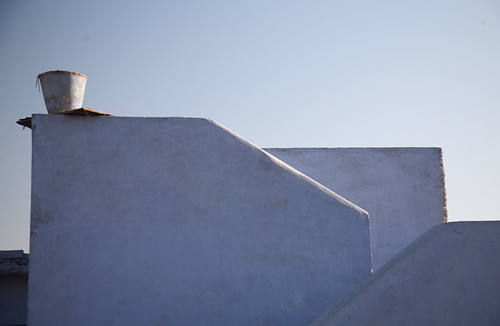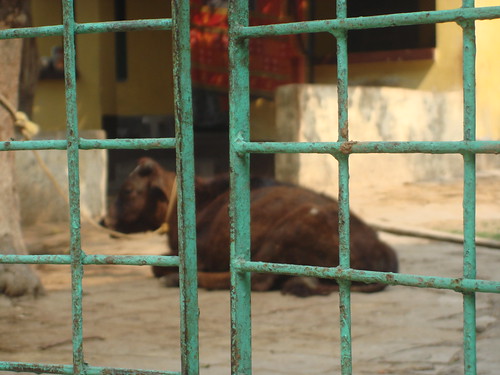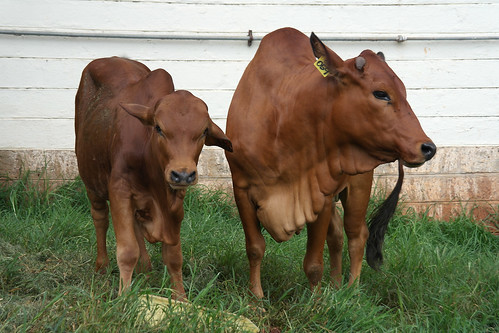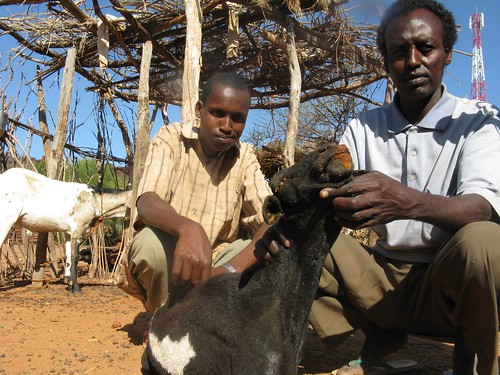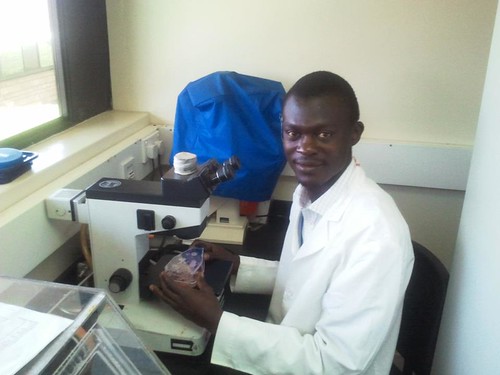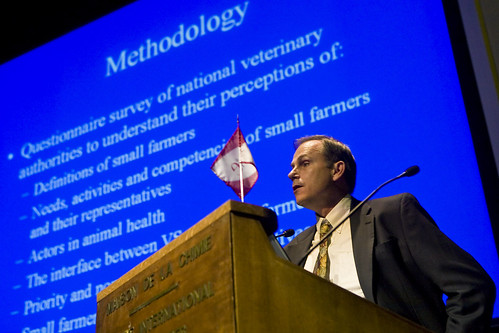Slide from presentation made by ILRI director general Jimmy Smith at the Africa Livestock Conference and Exhibition 2013 (credit: ILRI/Jimmy Smith).
Yesterday, Jimmy Smith, director general of the International Livestock Research Institute (ILRI), briefed Felix Kosgey, Kenya’s new cabinet secretary for Agriculture, Livestock and Fisheries, who was guest of honour at the opening of the African Livestock Conference and Exhibition (ALiCE), on key messages delivered during the opening session of the conference.
ILRI director general Jimmy Smith took the opportunity at this conference, being held this week (26–28 Jun 2013) in Nairobi, Kenya, to speak about the enormous opportunity, as well as special challenges, the livestock sector presents Africa at this particular moment, with the sector’s many direct current and potential twin benefits in terms of both agricultural prosperity and agricultural sustainability.
‘The theme for this conference and exhibition is Towards a competitive and sustainable world-class livestock sector.
. By then, with about 2.5 billion more people than there are now, 60–70% more food will have to be produced on a fixed land base that some argue is reaching its ecological limits. This theme addresses the global concern, even anxiety, about how the world will feed itself by the time the human population is expected to stabilize at over 10 billion by about mid-century
The livestock sector must play a major role in meeting our food and nutritional security here in Africa and the world over. I say food and nutritional security because one can be fed but not be nourished; the livestock sector contributes to both.
‘The livestock sector in the developing world is growing very rapidly. In these regions, the sector contributes between 30 and 40% of agricultural gross domestic product (GDP), with this growth driven by increasing population, urbanization and, in particular, incomes.
‘This rapid growth in demand for animal-source foods will continue well into the future because per capita consumption of milk, meat and eggs is still quite low in the developing world. Here in Africa, for example, per capita consumption is only about 10kg a year, whereas in the USA it’s about 100kg. As incomes continue to rise in Africa, which has some of the world’s fastest-growing economies, so, too, will demand for animal-source foods.
Little known or appreciated is that more than 50% of the world’s supply of animal-source foods comes from small-scale livestock producers. Here in Africa, some 70% of the supply of milk, meat and eggs is produced by smallholder farmers and herders.
‘Also here in Africa, consumption of animal-source foods will increase greatly between 2000 and 2030. The total percent increases between actual 2000 and anticipated 2030 figures are dramatic:
Africa’s consumption of poultry meat will increase by 200%, beef by over 100%, pork by 150% and milk by about 100%.
In Africa in 2006/07 (base years), the value of all animal-source foods consumed, excluding eggs, was USD33 billion.
Around the time population growth is expected to stabilize on the continent, in 2050, the value of animal-source foods consumed is projected to reach USD107 billion.
A critical part of our deliberations at this conference will be how to facilitate full participation of smallholder producers in this rapidly expanding livestock market.
‘There is a sobering side to this livestock growth story; increasingly, a larger and larger share of this rapidly rising demand for animal-source foods in Africa is being met by imports, despite the fact that the continent is extremely well endowed with livestock resources and the potential of the sector is vast.
Despite the importance of the livestock sector, it remains largely neglected, with discussions on agriculture by policymakers and others invariably still focused on crops.
‘The neglect of the sector, and in particular the potential of 200 million small-scale livestock producers, not only condemns the continent to steeply rising import bills but also ensures that we will miss an enormous opportunity to meet the need for food and nutritional security while also creating prosperity and transforming rural economies.
‘Here in Kenya, I’m happy to say, the livestock sector receives more attention than in most other countries and we can see its commensurate growth and development.
‘I know that there are many powerful voices out there who say that the neglect of the livestock sector is justified because livestock contribute to global warming, and high levels of meat consumption contribute to obesity and the poor health that often comes with it.
‘Regarding the livestock and environment issue, we can make livestock systems much more environmentally sustainable and we are working to do so. For example, we can cut the carbon footprint per unit of livestock product as aggressively as we can increase the productivity of cattle, sheep and goats.
Regarding the meat and obesity issue, I would argue that there is no moral equivalent between those who make poor a choice of food and those who have no choice of food.’
Jimmy Smith made his presentation to Kenya cabinet secretary Felix Kosgey on behalf of all the co-organizers and co-hosts of ALiCE, including:
- African Union–Interafrican Bureau for Animal resources (AU-IBAR)
- Eastern Africa Farmers Federation (EAFF)
- Eastern and Southern Africa Dairy Association (ESADA)
- Global Alliance for Livestock Veterinary Medicines (GALVmed)
- International Livestock Research Institute (ILRI)
- Kenya Livestock Producers Association (KLPA)
- New Kenya Co-operative Creameries (New KCC)
- Unga Ltd.
About the conference
ALiCE is the largest convergence of stakeholders in the livestock sector in Africa. This is a platform specifically aimed at stimulating trade in livestock and livestock products in Africa and beyond and facilitating technology and knowledge transfer and sharing. The event brings together producers, processors and traders of livestock and livestock products and suppliers of technology, solutions and services in the entire value chain.

